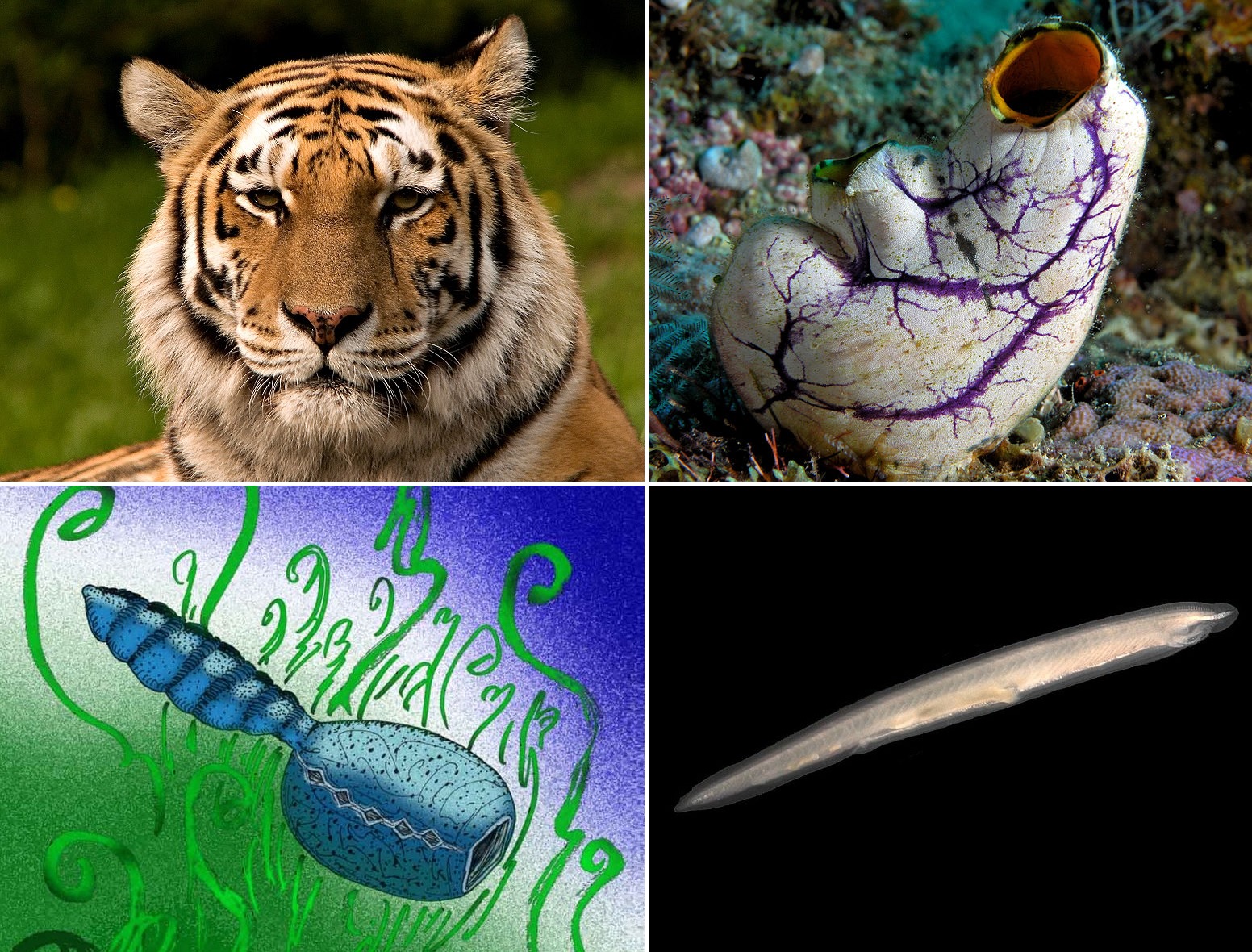 Phylum – Chordata · Animals belonging to phylum Chordata are fundamentally characterised by the presence of a notochord, a dorsal hollow nerve cord and paired pharyngeal [relating to the pharynx] gill slits.
Phylum – Chordata · Animals belonging to phylum Chordata are fundamentally characterised by the presence of a notochord, a dorsal hollow nerve cord and paired pharyngeal [relating to the pharynx] gill slits.· They are bilaterally symmetrical, triploblastic, coelomate with organ-system level of organisation.
· Phylum Chordata is divided into three subphyla: Urochordata or Tunicata, Cephalochordata and Vertebrata.
· Subphyla Urochordata and Cephalochordata are often referred to as protochordates and are exclusively marine.
· In Urochordata, notochord is present only in larval tail, while in Cephalochordata, it extends from head to tail region and is persistent throughout their life.
· Examples: Urochordata – Ascidia, Salpa, Doliolum; Cephalochordata – Amphioxus or Lancelet.
Comparison of Chordates and Non-chordates
S.No.
Chordates
Non-chordates
1.
Notochord present.
Notochord absent.
2.
Central nervous system is dorsal, hollow and single.
Central nervous system is ventral, solid and double.
3.
Pharynx perforated by gill slits.
Gill slits are absent.
4.
Heart is ventral.
Heart is dorsal (if present).
5.
A post-anal part (tail) is present.
Post-anal tail is absent.
Characteristics of Chordata
Animals in the phylum Chordata share four key features that appear at some stage during their development: a notochord, a dorsal hollow nerve cord, pharyngeal slits, and a post-anal tail (Figure 2). In some groups, some of these are present only during embryonic development.
The chordates are named for the notochord, which is a flexible, rod-shaped structure that is found in the embryonic stage of all chordates and in the adult stage of some chordate species. It is located between the digestive tube and the nerve cord, and provides skeletal support through the length of the body. In some chordates, the notochord acts as the primary axial support of the body throughout the animal’s lifetime. In vertebrates, the notochord is present during embryonic development, at which time it induces the development of the neural tube and serves as a support for the developing embryonic body. The notochord, however, is not found in the postnatal stage of vertebrates; at this point, it has been replaced by the vertebral column (that is, the spine).
Figure 2. In chordates, four common features appear at some point during development: a notochord, a dorsal hollow nerve cord, pharyngeal slits, and a post-anal tail.
PRACTICE QUESTION
Which of the following statements about common features of chordates is true?
a. The dorsal hollow nerve cord is part of the chordate central nervous system.
b. In vertebrate fishes, the pharyngeal slits become the gills.
c. Humans are not chordates because humans do not have a tail.
d. Vertebrates do not have a notochord at any point in their development; instead, they have a vertebral column.
Show Answer
The dorsal hollow nerve cord derives from ectoderm that rolls into a hollow tube during development. In chordates, it is located dorsal to the notochord. In contrast, other animal phyla are characterized by solid nerve cords that are located either ventrally or laterally. The nerve cord found in most chordate embryos develops into the brain and spinal cord, which compose the central nervous system.
Pharyngeal slits are openings in the pharynx (the region just posterior to the mouth) that extend to the outside environment. In organisms that live in aquatic environments, pharyngeal slits allow for the exit of water that enters the mouth during feeding. Some invertebrate chordates use the pharyngeal slits to filter food out of the water that enters the mouth. In vertebrate fishes, the pharyngeal slits are modified into gill supports, and in jawed fishes, into jaw supports. In tetrapods, the slits are modified into components of the ear and tonsils. Tetrapod literally means “four-footed,” which refers to the phylogenetic history of various groups that evolved accordingly, even though some now possess fewer than two pairs of walking appendages. Tetrapods include amphibians, reptiles, birds, and mammals.
The post-anal tail is a posterior elongation of the body, extending beyond the anus. The tail contains skeletal elements and muscles, which provide a source of locomotion in aquatic species, such as fishes. In some terrestrial vertebrates, the tail also helps with balance, courting, and signaling when danger is near. In humans, the post-anal tail is vestigial, that is, reduced in size and nonfunctional.
Origin of chordates
Origin of chordates :
Chordates evolved sometime during Cambrian period, 500 million years ago during Cambrian explosion, almost at the same time when invertebrates were beginning to evolve. They may have evolved from some freshwater forms as Chamberlain (1900) pointed out that all modern chordates possess glomerular kidneys that are designed to remove excess water from body. However, early fossils of chordates have all been recovered from marine sediments and even modern protochordates are all marine forms. Also glomerular kidneys are also found in some marine forms such as myxinoids and sharks. That makes the marine origin of chordates more plausible.
Chordates evolved from some deuterostome ancestor (echinoderms, hemichordates, pogonophorans etc.) as they have similarities in embryonic development, type of coelom and larval stages. Fossils of the earliest vertebrates are known from the Silurian-Devonian period, about 400 million years ago. The following theories have been given to explain the origin of chordates:
1. Echinoderm Origin. The theory was given by Johannes Muller (1860) and is based on the comparative studies of larval stages of echinoderms and hemichordates. Tornaria larva of hemichordates resembles echinoderm larvae such as Bipinnaria, Auricularia, Dipleurula and Doliolaria, which all possess ciliary bands and apical tuft of cilia. Johannes Muller, W. Garstang and DeBeers proposed that echinoderm larvae gave rise to chordates by neoteny. Also like chordates, echinoderms are also deuterostomes and possess mesodermal skeletal elements.
The discovery of fossil echinoderms called Calcichordata from Ordovician period (450 mya) further confirms echinoderm ancestry of chordates. Calcichordates were asymmetrical animals which demonstrate affinities with both echinoderms and chordates but their skeleton is made of CaCO3 whereas in vertebrates the bones are made of hydrated Ca and phosphate. They had large pharynx with a series of gill slits, each covered with flaps for filter feeding, a small segmented body and a postanal tail. A perforated pharynx for filter feeding appears to have evolved in diverse groups of animals during Cambrian-Orodovician periods when planktons were abundant in water.
2. Hemichordate Origin. Romer (1959) suggested that ancestral deuterostomes were sedentary tentacle feeders whose mucous-laden ciliated tentacles served to trap planktons as they were waved in water as do the modern lophophorates and pterobranch hemichordates, Cephalodiscus and Rhabdopleura. By some mutation pharyngeal gill slits evolved in these ancestors, which made the pharynx sieve-like to trap planktons as the water current passed through it. Extant pterobranchs possess both ciliated arms and pharyngeal gill slits. Tornaria larva of hemichordates shows phylogenetic relationship with echinoderm larvae and hemichordates also show affinities with chordates.
3. Urochordate Origin. W. Garstang (1928) and N.J. Berrill (1955) gave importance to the tadpole-like larva of urochordates which carries typical chordate characters, namely, a notochord in tail along with segmented myotomes, dorsal hollow nerve cord, sense organs and pharyngeal gill slits. Garstang (1928) suggested that chordates evolved from some sessile filter feeding urochordate by the larval stage evolving into adult by neoteny and by losing the sedentary adult stage.
4. Cephalochordate Origin. Chamberlain (1900) studied the primitive and advanced characters of cephalochordates and proposed that while extant cephalochordates possess all chordate characters in typical state, they also show some primitive features of non-chordates, such as, absence of heart, head, sense organs, respiratory pigment, filter-feeding mode of food capture and excretion by solenocytes. Fossils of 60 specimens from mid-Cambrian of the earliest chordate, Pikaia gracilens have been discovered from Burgess Shale in British Columbia, Canada. The Amphioxus-like fossils show streamlined, ribbon-shaped, 5 cm long body having notochord in the posterior two-third of body and myomeres. It has a small head with two tentacles and gill slits in the neck region. Other chordate-like fossils are: Cathaymyrus from early Cambrian sediments in China and Palaeobranchiostomata from early Permian from South Africa that appears to be more similar to Amphioxus.
5. Combined theory. E.J.W. Barrington (1965) combined all the above theories and proposed that the common ancestor of echinoderms and chordates was a sessile ciliary arm feeder that lived in the plankton-rich environment of the Cambrian. Modern Crinoidea (Echinodermata), Pogonophora and Pterobranch hemichordates evolved from a similar ancestor by retaining the original mode of feeding, perhaps because they continued to inhabit the same environment as occurred in ancestral days. However, pharyngotremy (perforation of pharynx with gill slits) must have evolved in a large number of groups at that time, which must have been much more superior method of food gathering by filtering water through pharynx as compared to ciliated arm feeding. Hence, the sedentary Protoascidians of that time lost ciliated arm feeding and adopted pharyngeal filter feeding as the only method of food gathering. Sometime later, when the plankton population in water declined, free-swimming tailed larva of these urochordates did not metamorphose and became a neotenic adult, since free-swimming mode was superior in food searching at a time of food scarcity. Cephalochordate-like ancestors evolved by perfection and expansion of chordate characters that were already present in the ascidian tadpole larva. We already have fossils of such primitive chordates.
Chordate Features Shared by the Non-Chordates:
Besides the four unique features of the chordates, there are many characteristics which are also present in many higher invertebrate chordates. The significance of the structural similarities is very difficult to interpret from the phylogenetic point of view.
However, it may be suggested that the chordates as a group evolved from some higher groups of non-chordates and, hence, the structural resemblances are due to remote common ancestry.
Bilateral Symmetry:
Both the chordates and most of the non-chordates like annelids, arthropods, etc. exhibit distinct bilateral symmetry.
Axiate Organization:
All the chordates have a distinct polar axis. The anterior end is marked by the presence of head and the posterior end is characterised in most cases by the tail. The axis extending from the head to the tail end is regarded as the anteroposterior axis.
The anteroposterior axis of the chordates corresponds to that of most of the higher non-chordates. The axiate organization is not strictly homologous, because many fundamental differences exist between the two groups.
Triploblastic Condition:
All animals above the rank of cindarian coelenterates have a third germ layer besides ectoderm and endoderm. This third layer is known as mesoderm.
Although the embryonic formation of the mesoderm is different in non-chordates, its formation is similar in chordates, echinoderms, brachiopods, chaetognaths and in some other enterocoelous forms. The triploblastic condition has added more weight to the phylogenetic relationship of the chordates with the non-chordates.
Metamerism:
Segmental organisation is characteristic of most of the non-chordates and the chordates. In annelids and arthropods, segmentation is well-marked both internally as well as externally but in chordates the external segmentation is not seen. The segmental arrangement of the body wall musculature is prominent in chordates.
Coelom:
The eucoelom or true coelom is the secondary body cavity of triploblastic animals, situated between the gut and body wall. The space of body cavity is lined by coelomic epithelium and contains coelomic body fluid.
The mode of origin of coelom is different among the different groups of invertebrates and chordates. In annelids, arthropods and molluscs the coelom formation is of schizocoelic type, because the coelom develops by the splitting of the embryonic mesoderm layer.
In echinoderms, hemichordates and in other chordates the coelom formation is of enterocoelic type, or the coelom is called enterocoel, because the coelom develops from the embryonic archenteron or enteron. Here mesoderm arises in the embryo as paired lateral pouches growing out from the endoderm.
These pouches gradually lose continuity with the endoderm and grow downwards and inwards until they meet and fuse. The inner splanchnic part remains against the wall of developing gut and outer somatic part of the mesoderm becomes applied against the developing body wall.
Embryonic Development:
Protostome and deuterostome are the two groups of animals which differ in the embryonic origin of the mouth. Among protostomes, the mouth is formed from the blastopore, hence protostome means ‘first mouth’. Among the deuterostomes, the mouth does not form from blastopore. Instead it may give rise to anus.
In this group the mouth is the second opening, hence called deuterostome. The differences on the basis of embryological development have strongly supported by analysis of phosphate-containing storage molecules that are found in muscles and are used in the synthesis of ATP.
Ancestry of Phylum Chordata:
The chordates include organisms having a notochord, a dorsal hollow nerve cord, pharyngeal slits or pouches and a few features like bilateral symmetry, axial organisation, triploblastic condition, segmentation, etc., that are common with the non-chordates. The question of the origin of the chordates still remains unanswered and considerable controversy exists on this issue.
The geological records established beyond doubt that the chordates originated prior to Cambrian period because the relics of some lower chordate forms have been discovered in Cambrian strata. There are various theories regarding the origin of the chordates from the non-chordate groups. Most of the theories suffer from serious defects.
Of all the theories regarding the ancestry of chordates from some non-chordates, Garstang’s suggestion that the chordates have evolved from some free-swimming echinoderm larvae (possibly auricularian larvae) by means of paedomorphosis has been accepted by many workers.
The role of paedogenesis (reproduction in pre-adult stage) in evolutionary dynamics is emphasised by many workers on this line. But in recent years the ancestry of the chordates from the echinoderm source is not accepted.
Recent workers regard the differences between the vertebrates and the non-chordates (invertebrates) to be artificial in nature. Inclusion of the echinoderms, pogonophores and chordates under deuterostomia (animals where the anus develops from the blastopore and the mouth is formed anew) is accepted nowadays. The protochordates (urochordates and cephalochordates) are the members of the Phylum Chordata.
The protochordates provide connecting link between the vertebrates with other deuterostomes. The deutorostomes are highly specialised groups and it will be improper to regard them in the direct line of vertebrate descent.
The phylogenetic status of the hemichordates is a subject of great controversy. But the chordate nature of the urochordates and the cephalochordates is well-established though their relationships with the vertebrates and with each other are difficult to ascertain.
Barrington (1965) suggested that the deuterostomes have evolved from sessile/semi-sessile ancestors having bilaterally symmetrical and tripartite body and coelom. The echinoderms have departed a long way frohttps://www.biologydiscussion.com/animals-2/phylum-chordata/phylum-chordata-meaning-features-and-ancestry-biology/40429m the ancestors, while the hemichordates remained closer.
The hemichordates have developed pharyngotremy (i.e., existence of openings in the pharyngeal wall) which is associated with its ciliary mode of feeding. In course of time a group with internal food collection mechanism by elaborate and complicated pharynx gave rise to the urochordates, cephalochordates and vertebrates.
PROTOCHORDATES
Ø The organisms belonging to the Protochordata are generally known as the lower chordates. They are divided into three sub-phyla- Hemichordata, Urochordata, Cephalochordata.
Ø Protochordate is an informal category of organisms to describe the invertebrates that are closely related to vertebrates.
Ø The Chordates are identified by the presence of a notochord. On the contrary, the Protochordates lack a true notochord.
Ø A notochord is the primitive beginning of the backbone found in the embryonic stage. These are only found in the organisms belonging to phylum Chordata. coelomated.- At a certain stage of their lives, their body
develops a long, rod-like structure for support called the notochord.
- They exhibit organ system level of organization.
Eg., Herdmania, Amphioxus
Classifications of
Protochordata
Hemichordata
- They are found in marine water.
- Some live solitarily, and some stay in colonies.
- The body is cylindrical, unsegmented, and stout.
- The body is divided into proboscis, collar, and
trunk.
- The collar bears arms and tentacles.
- They have a complete digestive system.
- They respire through gills or general body surface.
- The circulatory system comprises of a heart with two
longitudinal vessels.
- The blood has no colour and corpuscles.
- The proboscis gland or glomerulus make up the excretory system.
- Sexes may be separate or united and fertilization is
either internal or external.
- Eg., Cephalodiscus, Rhabdopeura
Urochordata or Tunicata
- They are found in the marine environment.
- They are sessile and filter-feeders.
- They are also known as tunicates because their body
is surrounded by a leathery sheath composed of tunicin (cellulose).
- The notochord appears in the larval stage in the
tail of the larva and disappears in the adult. This is known as
retrogressive metamorphosis.
- The neural tube in the larva is replaced by a dorsal
ganglion in the adults.
- Respiration occurs through gills.
- They have an open circulatory system.
- The excretory organs are absent.
- They reproduce asexually by budding.
- Eg., Herdmania, Selpa
Cephalochordata
- They are marine and filter-feeders.
- The notochords remain throughout life and extend up
to the head region.
- The nerve cord and the tail also remain throughout
life.
- Solenocyts are the excretory organs.
- They respire through gills which open in the atrium.
- The body wall comprises of myotomes.
- Eg., Amphioxus
Vertebrate
Alternative Titles: Craniata, Vertebrata
Vertebrate, also called Craniata, any animal of the subphylum Vertebrata, the predominant
subphylum of the phylum Chordata. They have backbones, from which they derive their
name. The vertebrates are also characterized by a muscular system consisting
primarily of bilaterally paired masses and a central nervous system partly enclosed within the backbone.
The major groups of vertebrates include fishes,
amphibians, reptiles, birds, and mammals.Encyclopædia Britannica, Inc.
The subphylum is one of the best known of all
groups of animals. Its members include the classes Agnatha, Chondrichthyes, and Osteichthyes (all
fishes); Amphibia (amphibians); Reptilia (reptiles); Aves (birds); and Mammalia (mammals).
General
characters
Ø Although the vertebral column is perhaps the most
obvious vertebrate feature, it was not present in the first vertebrates, which
probably had only a notochord.
Ø The
vertebrate has a distinct head, with a differentiated tubular brain and three pairs of sense organs (nasal, optic, and
otic).
Ø The body is divided into trunk and tail regions. The presence of pharyngeal slits
with gills indicates a relatively high metabolic rate.
Ø A well-developed notochord enclosed in perichordal connective tissue, with a tubular spinal cord in a connective tissue canal above it, is flanked by a number of segmented muscle masses.
Ø A
sensory ganglion develops on the dorsal root of the spinal nerve, and segmental autonomic ganglia grow below the
notochord.
Ø The trunk
region is filled with a large, bilateral body cavity (coelom) with contained
viscera, and this coelom extends anteriorly into the visceral arches.
Ø A digestive
system consists of an esophagus extending from the pharynx to the stomach and
a gut from the stomach to the anus.
Ø A distinct
heart, anteroventral to the liver, is enclosed in a pericardial sac. A basic
pattern of closed circulatory vessels is largely preserved in most living
forms.
Ø Unique,
bilateral kidneys lie retroperitoneally (dorsal to the main body cavity) and
serve blood maintenance and excretory functions.
Ø Reproductive
organs are formed from tissue adjacent to the kidneys; this original close
association is attested by the tubular connections seen in males of living
forms.
Ø The ducts of
the excretory organs open through the body wall into a cloacal chamber, as does
the anus of the digestive tract.
Ø Reproductive
cells are shed through nearby abdominal pores or through special ducts. A
muscular tail continues the axial musculature of the trunk.
Vertebrata
- These animals have a true vertebral column and internal skeleton, allowing a completely different distribution of muscle attachment points to be used for movement.
- The members of subphylum Vertebrata possess notochord during the embryonic period.
- The notochord is replaced by a cartilaginous or bony vertebral column in the adult.
- Thus all vertebrates are chordates but all chordates are not vertebrates.
- Besides the basic chordate characters, vertebrates have a ventral muscular heart with two, three or four chambers, kidneys for excretion and osmoregulation and paired appendages which may be fins or limbs.
- Vertibrates are bilaterally symmetrical, triploblastic, coelomic and segmented, with complex differentiation of body tissues and organs.
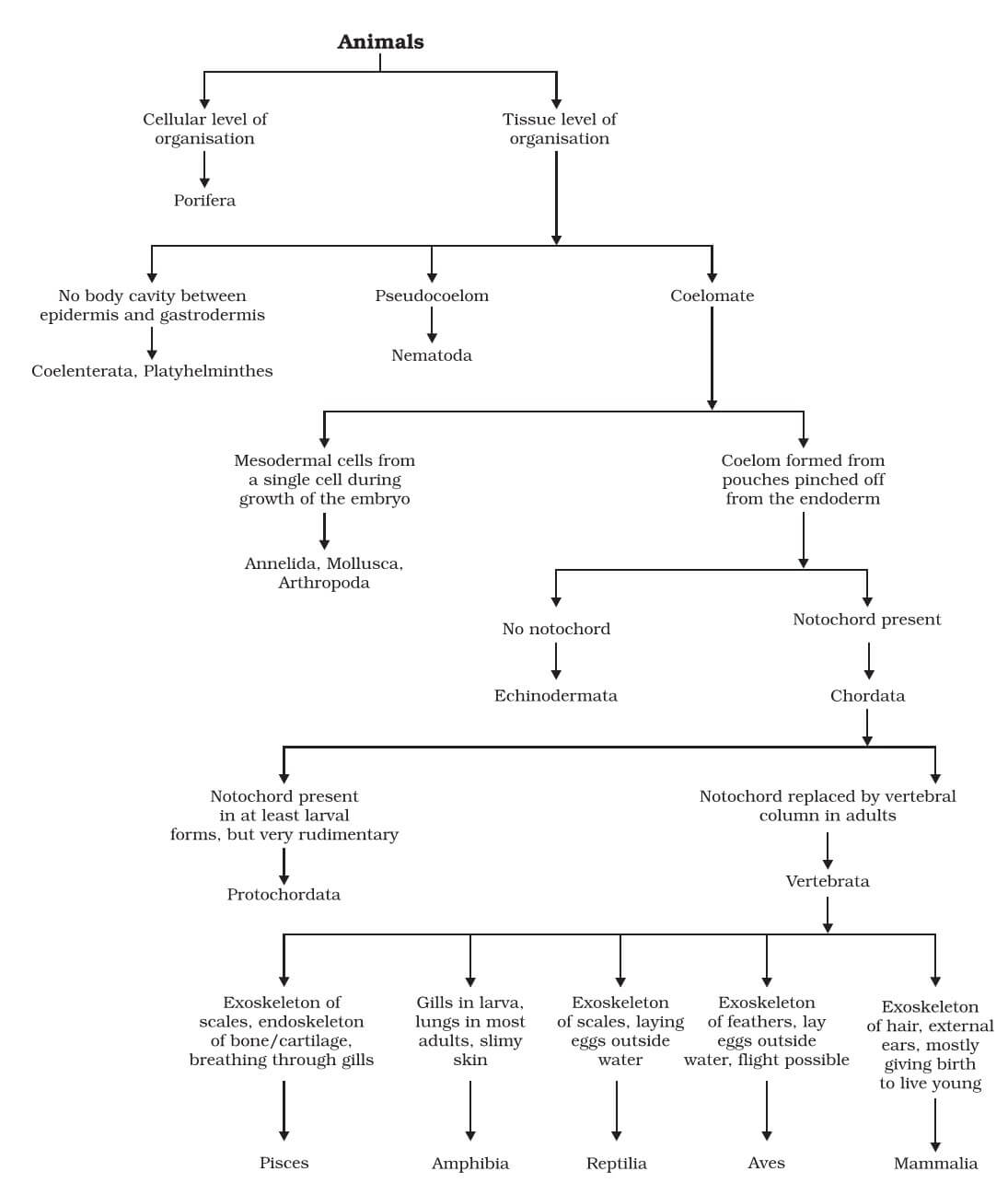
Division In Vertebrata
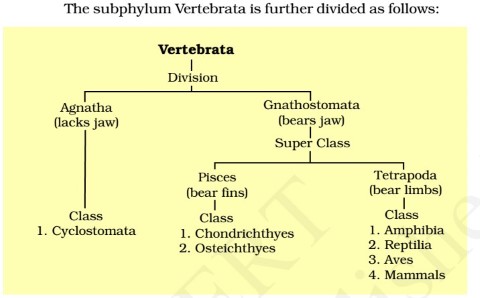
Basic ConceptsViviparous and Oviparous Animals
Warm Blooded vs. Cold Blooded Animals
Hibernation
|
Class – Cyclostomata
- All living members of the class Cyclostomata are ectoparasites [ives on the outside of its host] on some fishes.
- They have an elongated body bearing 6-15 pairs of gill slits for respiration.
- Cyclostomes have a sucking and circular mouth without jaws.
- Their body is devoid of scales and paired fins.
- Cranium and vertebral column are cartilaginous.
- Circulation is of closed type.
- Cyclostomes are marine but migrate for spawning [release or deposit eggs] to fresh water.
- After spawning, within a few days, they die. Their larvae, after metamorphosis [transformation from an immature form to an adult form in two or more distinct stages. Example: Larvae → Tadpole → Frog], return to the ocean.
- Examples: Petromyzon (Lamprey) and Myxine (Hagfish).
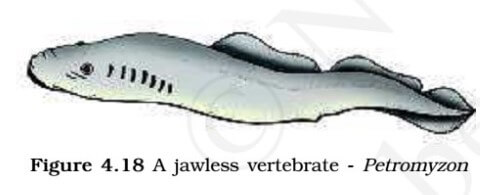
Class – Pisces
- These are fish. Their skin is covered with scales/plates. They lay eggs [oviporous].
- They obtain oxygen dissolved in water by using gills.
- The body is streamlined, and a muscular tail is used for movement.
- They are cold-blooded and their hearts have only two chambers, unlike the four that humans have.
- Some fish skeletons are made entirely of cartilage [Chondrichthyes], such as sharks, and some with a skeleton made of both bone and cartilage [Osteichthyes].

Chondrichthyes
- They are marine animals with streamlined body and have cartilaginous endoskeleton. Mouth is located ventrally.
- Notochord is persistent throughout life.
- Gill slits are separate and without operculum (gill cover).
- The skin is tough, containing minute placoid scales.
- Teeth are modified placoid scales which are backwardly directed.
- Their jaws are very powerful.
- These animals are predaceous [shark].
- Due to the absence of air bladder, they have to swim constantly to avoid sinking.
- Heart is two-chambered (one auricle and one ventricle).
- Some of them have electric organs (e.g., Torpedo) and some possess poison sting (e.g., Trygon).
- They are cold-blooded (poikilothermous) animals, i.e., they lack the capacity to regulate their body temperature.
- Sexes are separate. In males pelvic fins bear claspers.
- They have internal fertilisation and many of them are viviparous [give birth to young ones].
- Examples: Scoliodon (Dog fish), Pristis (Saw fish), Carchaiodon (Great white shark), Trygon (Sting ray).
Osteichthyes
- It includes both marine and fresh water fishes with bony endoskeleton.
- Their body is streamlined. Mouth is mostly terminal.
- They have four pairs of gills which are covered by an operculum on each side.
- Skin is covered with cycloid/ctenoid scales.
- Air bladder is present which regulates buoyancy.
- Heart is two- chambered (one auricle and one ventricle).
- They are cold-blooded
- Sexes are separate.
- Fertilisation is usually external.
- They are mostly oviparous and development is direct.
- Examples: Flying fish, Sea horse, Fighting fish, Angel fish etc.
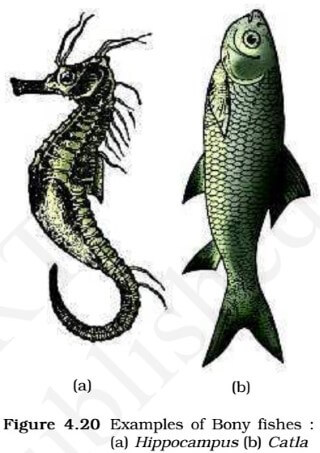
Class – Amphibia
- As the name indicates (Gr., Amphi : dual, bios, life), amphibians can live in aquatic as well as terrestrial habitats.
- The amphibian skin is moist without scales [mucus glands in the skin]. The eyes have eyelids. A tympanum represents the ear.
- Alimentary canal, urinary and reproductive tracts open into a common chamber called cloaca which opens to the exterior.
- They have a three-chambered heart (two auricles and one ventricle). These are cold-blooded
- Respiration is through gills, lungs and through
- Respiration is by gills, lungs and through skin.
- Sexes are separate. Fertilisation is external.
- They are oviparous and development is indirect.
- Examples: Toad, Frog), Tree frog, Salamander, Limbless amphibia.
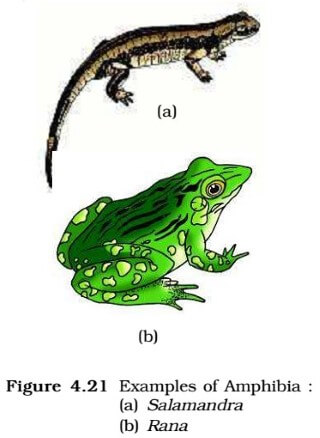
Class – Reptilia
- The class name refers to their creeping or crawling mode of locomotion (Latin, repere or reptum, to creep or crawl).
- They are mostly terrestrial animals and their body is covered by dry and cornified skin, epidermal scales or scutes. Snakes and lizards shed their scales as skin cast.
- They do not have external ear openings. Tympanum represents ear. Limbs, when present, are two pairs.
- Heart is usually three-chambered, but four-chambered in crocodiles.
- Reptiles are poikilotherms [cold-blooded animals].
- They lay eggs with tough coverings and do not need to lay their eggs in water, unlike amphibians.
- Sexes are separate.
- Fertilisation is internal.
- They are oviparous and development is direct.
- Examples: Turtle), Tortoise, Chameleon (Tree lizard), Garden lizard, Crocodile, Alligator, Wall lizard, Poisonous snakes – Naja (Cobra), Bangarus (Krait), Vipera (Viper).
Class – Aves
- They have a four-chambered heart. They breathe through lungs. All birds fall in this category.
- The characteristic features of Aves (birds) are the presence of feathers and most of them can fly except flightless birds (e.g., Ostrich). The forelimbs are modified into wings.
- The hind limbs generally have scales and are modified for walking, swimming or clasping the tree branches.
- Skin is dry without glands except the oil gland at the base of the tail.
- Endoskeleton is fully ossified (bony) and the long bones are hollow with air cavities (pneumatic).
- The digestive tract of birds has additional chambers, the crop and gizzard.
- They are warm-blooded (homoiothermous) animals, i.e., they are able to maintain a constant body temperature.
- Respiration is by lungs. Air sacs connected to lungs supplement respiration.
- Sexes are separate. Fertilisation is internal. They are oviparous and development is direct.
- Examples : Crow, Pigeon, Ostrich), Neophron (Vulture) etc..
Class – Mammalia
- Mammals are warm-blooded animals with four-chambered hearts.
- Most mammals familiar to us produce live young ones. However, a few of them, like the Platypus and the Echidna lay eggs, and some, like kangaroos give birth to very poorly developed young ones.
- They are found in a variety of habitats – polar ice caps, deserts, mountains, forests, grasslands and dark caves. Some of them have adapted to fly or live in water.
- The most unique mammalian characteristic is the presence of milk producing glands (mammary glands) by which the young ones are nourished.
- They have two pairs of limbs, adapted for walking, running, climbing, burrowing, swimming or flying.
- The skin of mammals is unique in possessing hair. External ears or pinnae are present. Different types of teeth are present in the jaw.
- Heart is four-chambered. They are homoiothermous [warm-blooded]. Respiration is by lungs.
- Sexes are separate and fertilisation is internal.
- They are viviparous with few exceptions and development is direct.
- Examples: Oviparous – Platypus; Viviparous – Kangaroo, Flying fox), Delphinus (Common dolphin), Balaenoptera (Blue whale), etc.
Animal Classification Summary
- Porifera includes multicellular animals which exhibit cellular level of organisation and have characteristic flagellated choanocytes.
- The coelenterates have tentacles and bear cnidoblasts. They are mostly aquatic, sessile or free-floating. The ctenophores are marine animals with comb plates.
- The platyhelminths have flat body and exhibit bilateral symmetry. The parasitic forms show distinct suckers and hooks.
- Aschelminthes are pseudocoelomates and include parasitic as well as non-parasitic round worms.
- Annelids are metamerically segmented animals with a true coelom.
- The arthropods are the most abundant group of animals characterised by the presence of jointed appendages.
- The molluscs have a soft body surrounded by an external calcareous shell. The body is covered with external skeleton made of chitin.
- The echinoderms possess a spiny skin. Their most distinctive feature is the presence of water vascular system.
- The hemichordates are a small group of worm
- -like marine animals. They have a cylindrical body with proboscis, collar and trunk.
- Phylum Chordata includes animals which possess a notochord either throughout or during early embryonic life. Other common features observed in the chordates are the dorsal, hollow nerve cord and paired pharyngeal gill slits.
- Some of the vertebrates do not possess jaws (Agnatha) whereas most of them possess jaws (Gnathostomata). Agnatha is represented by the class, Cyclostomata. They are the most primitive chordates and are ectoparasites on fishes. Gnathostomata has two super classes, Pisces and Tetrapoda.
- Classes Chondrichthyes and Osteichthyes bear fins for locomotion and are grouped under Pisces. The Chondrichthyes are fishes with cartilaginous endoskeleton and are marine.
- Classes, Amphibia, Reptilia, Aves and Mammalia have two pairs of limbs and are thus grouped under Tetrapoda. The amphibians have adapted to live both on land and water.
- Reptiles are characterised by the presence of dry and cornified skin. Limbs are absent in snakes. Fishes, amphibians and reptiles are poikilothermous (coldblooded).
- Aves are warm-blooded animals with feathers on their bodies and forelimbs modified into wings for flying. Hind limbs are adapted for walking, swimming, perching or clasping.
- The unique features of mammals are the presence of mammary glands and hairs on the skin. They commonly exhibit viviparity.
its very good informationa
ReplyDelete